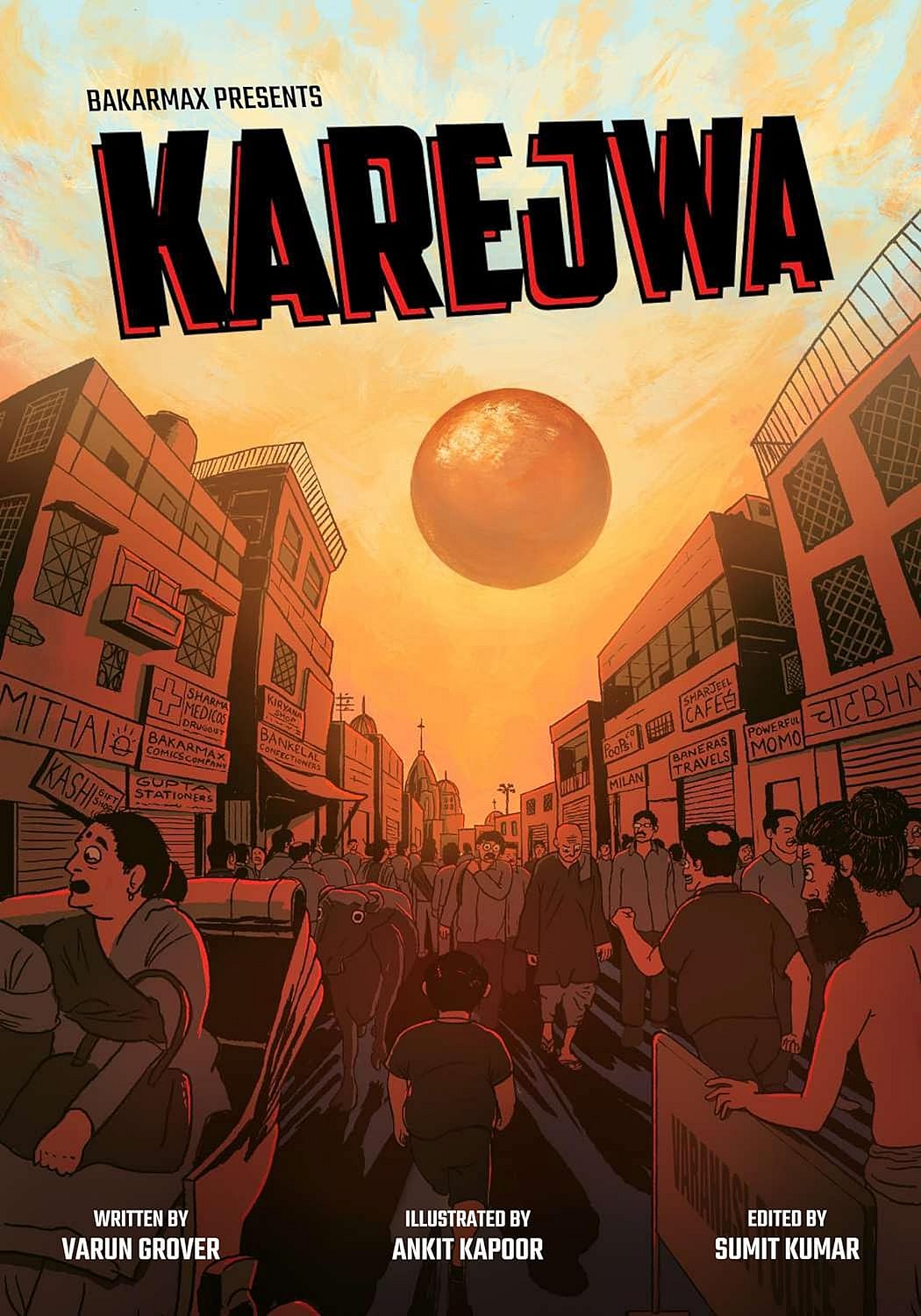The End Is Near

ALBERT EINSTEIN’S calculations irrevocably led to the concept of the Singularity, a point of zero volume and infinite density, that forms the beating heart of a black hole. All definitions, all knowledge breaks down here, and Reality itself loses its bearings. What could it conceivably look like? Many have posed this question, but few have answered thusly—it would look like the inside of a cosmic, colossal gulab jamun. This is Karejwa, a graphic novel drawn by Ankit Kapoor based on a short story by Varun Grover.
The premise is irresistible; the world is to end after a close encounter of the worst kind, from a gravitational brush with a dead star called ITR-688, or to use the moniker bestowed by the media— the “mrityu tara”. A TV news anchor (naturally dressed in a spacesuit) gleefully explains with the help of diagrams how it will all be “very exciting”, with a breakdown of the strong nuclear force that holds matter, annihilating earth into a featureless khichdi of elementary particles and resulting in even “innocent bystander planets” like Mars catching fire.
All this is the background, however. The clock is ticking and now only half an hour remains, as the death star whirls towards us like an in-swinging yorker.
The story is set in Varanasi, “the first city in the world”. Everyone has a final wish, something to do before the curtain comes down on the show, some want to go to the Ganga, others to riot and shout, but for the boy Pintoo, it is to eat a gulab jamun. We learn that the city has over 20,000 types of mithai from “baans ka murabba” (bamboo compote) to kathal ka laddu (made from jackfruit). There is even a mud barfi—made with lots of rosewater, sandalwood and other sundries. But Pintoo doesn’t care for any of these—he only wants the karejwa, the king of the sweets, a gulab jamun as “tender as a loved one’s broken heart”. And as chaos unfolds in the final half-hour of existence, he sets off on a quest to Kashi’s chaat bhandar.
2025 In Review
12 Dec 2025 - Vol 04 | Issue 51
Words and scenes in retrospect
Kapoor evokes the narrow bylanes of Varanasi, and the combination of relatively detailed backgrounds and the cartoony yet lively nature of the human figures delivers an immersive experience. The scale, whether shots of Jupiter or the corrugated surface of a kaju barfi is deftly manipulated. Towards the end, Kapoor captures the mounting dread and tension, with a reddish haze that swamps the pages presaging the arrival of the unwelcome cosmic visitor; the world begins resembling the inside of a gulab jamun.
“Pralay ab door nahin,” blares the ticker on a TV. This is a scientifically mandated form of what in Hindu eschatology would be dissolution. Folded within this is Yuganta, or the end of an aeon as well as a herald of its rebirth. Pintoo’s story is unfolding while the national project is undergoing a systematic rebooting, from the post-independence Nehruvian socialism to the present muscular ethno-nationalism. In the current worldview, the apocalypse has already happened, black holes have come and gone, with the downfall of the idyllic Vedic civilisation; hence all aspirational energies must be directed not into the future but backwards, to revive a golden past. Hence the beckoning nectarine hours of amrit kaal.
This aspirational rise is counter-pointed by the dystopic gloom in the perspective of the bhadralok, as one world ends, and another begins. In this narrative cycle, the sympathies of Grover, known for his anti-establishment stand-up comic routines, are clear. Kapoor uses TV screens showing news channels as panels to dole out context, hence we get to know that “10,000 devotees have entered Amarnath gufa” and therefore the “Indian future is assured”. These barbs are wrapped up in a plea for tolerance. In an extended origin story sequence we are reminded that Pintoo’s karejwa is the “unmatched prince born of the great hybrid culture of ganga-yamuna plains”. And that it was “the beautiful coming together of these two—Mughal and Aryan, milk and suji—that led to the invention of the gulab jamun”.

